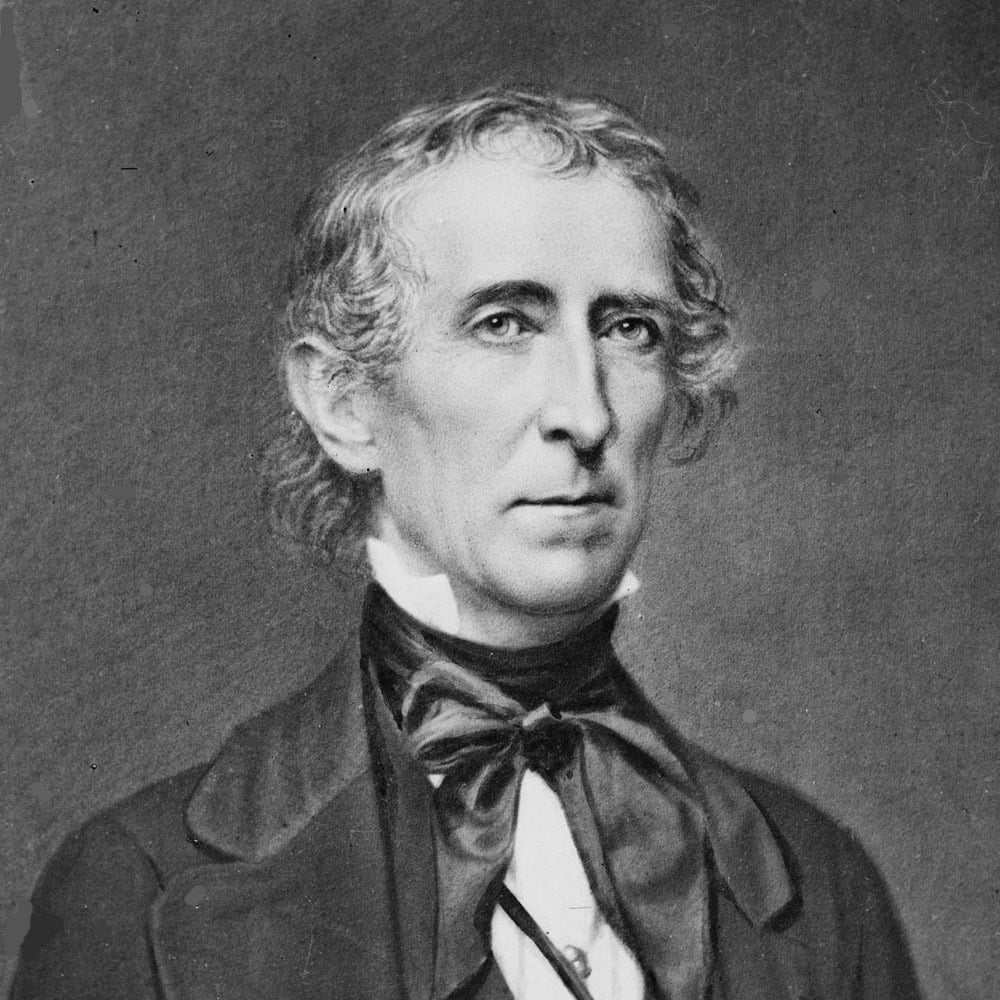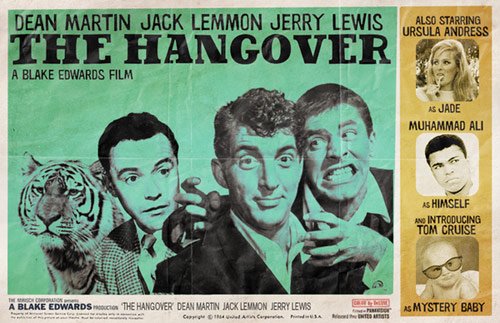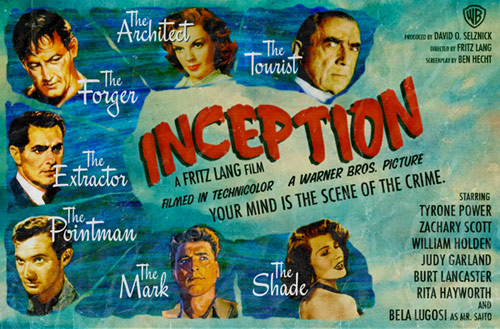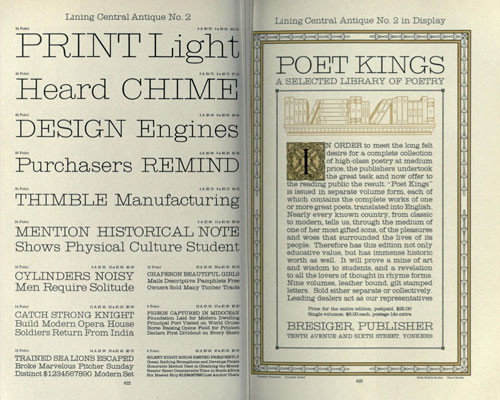What a five-year-old thinks about famous logos
Designer Adam Ladd asked his five-year-old daughter for her impressions of several well-known logos. This is great:
(via stellar)



This site is made possible by member support. 💞
Big thanks to Arcustech for hosting the site and offering amazing tech support.
When you buy through links on kottke.org, I may earn an affiliate commission. Thanks for supporting the site!
kottke.org. home of fine hypertext products since 1998.
Designer Adam Ladd asked his five-year-old daughter for her impressions of several well-known logos. This is great:
(via stellar)
Over at Sew Weekly, Mena Trott predicts what some of the characters will be wearing in the coming season of Mad Men.
Oh, Betty. For years, she has been immaculately dressed and presented as the facade of the perfect 1950s/1960s wife. With her cinched waists and billowing skirts, she’s held onto late 1950s and early 1960s fashion the longest. In season four, she’s married to the anti-Don, the boring Henry Francis and is getting a little too familiar with the bottle. When you’re married to Henry Francis, you just don’t care any more. That should be embroidered on a pillow.
Over at The Wirecutter, Brian Lam writes about technology, journalism, happiness, and why “clicking the like button 1 billion times will never give you an orgasm or a hug or a high five”.
The first thing I did was to take back my time. I quit all the online content that was id-provoking and knee jerk. I stopped reading the stupid hyped up news stories that are press releases or rants about things that will get fixed in a week. I stopped reading the junk and about the junk that was new, but not good. I stopped reading blogs that write stories like “top 17 photos of awesome clouds by iphone” and “EXCLUSIVE ANGRY BIRDS COMING TO FACEBOOK ON VALENTINES DAY.” And corporate news that only affects the 1%. Most days, I feel like most internet writers and editors are engaging in the kind of vapid conversation you find at parties that is neither enlightening or entertaining, and where everyone is shouting and no one is saying anything. I don’t have time for this.
The Eames’ Powers of Ten and Eva Szasz’s Cosmic Zoom both came out in 1968 and were based on Kees Boeke’s 1957 essay called Cosmic View. This seems like an incredible coincidence. I couldn’t find anything online about which film came first or if there was any influence one way or the other, so I thought I’d ask if anyone knows anything about which came out first. Hit me at [email protected].
The Pronunciation Book channel on YouTube shows you how to say various words in American English in a straightforward fashion. Here’s how to say Zegna, the men’s clothing brand:
This is not to be confused with the Pronunciation Manual channel, which does the same thing in the same format but much funnier and more incorrect.
I could have embedded a dozen more…I have no idea why I think these are so funny but I just cannot stop laughing at them. Ok, one more:
And this one! Make it stop!!
Update: My kids and I still use these mispronunciations around the house all the time. I cannot help looking at even the fanciest bottle of Châteauneuf-du-Pape without thinking choody-noofy-doopy-poopy.
Well some of them are. The plain old American Oreo didn’t sell so well in China, so Kraft had to rethink everything about the cookie.
It turns out that if you didn’t grow up with Oreos and develop an emotional attachment to the cookie, it can be a weird-tasting little thing. And this started a whole process in the Chinese division of Kraft of rethinking what the essence of an Oreo really is.
Key terms in this article include “the essence of Oreoness” and “Twist, Lick, Dunk”.
At the end of last week’s post about John Tyler’s grandsons still being alive (and indeed, NY Mag did an interview with one of them), I provided a couple of other examples of living persons bridging distant historical periods and asked:
Someone needs to come up with a term for this sort of thing (history bridges? no.)
On Twitter, David Galbraith suggested “timebenders”. After more thought, I came up with “human wormholes” but that’s not quite right either. Tony Hiss, in a book about his father Alger (the accused Soviet spy), said that Alger had a term for stories kind of like these: the Great Span.
My father himself even had a name for a kind of ongoing closeness between people in which death is sometimes only an irrelevance. He called it “the Great Span,” a sort of bucket brigade or relay race across time, a way for adjacent generations to let ideas and goals move intact from one mind to another across a couple of hundred years or more.
Hiss cites a pair of stories involving Alger (who died in 1996) and Oliver Wendell Holmes, who Alger clerked for and also figured in one of my earlier examples. In one story, Holmes told Alger about his experience fighting in the Civil War. The other story reaches back even further:
In the Holmes story Alger treasured above all others, the Justice told him that when he had been very young, his grandmother, a woman he revered, had shared her memories of the day at the beginning of the American Revolution when she was five and had stood in her father’s front window on Beacon Hill in Boston and watched rank after rank of Redcoats marching through town.
Another instance of the Great Span are the three Civil War widows (Maudie Hopkins, Alberta Martin, and Gertrude Janeway) who lived into the 2000s, two of them collecting their husbands’ pensions until their deaths. (thx, mike & @ithinkihaveacat)
If you divide 1 by the number 998,001, you get a list of all the three digit numbers in order except 998. Like so:

Math! (via mlkshk)
BLDGBLOG is running a distributed film festival called Breaking Out and Breaking In that will explore the architecture of escapes and break-ins in movies.
Breaking Out and Breaking In is an exploration of the use and misuse of space in escapes and heists, where architecture is the obstacle between you and what you’re looking for.
Watch the films at home-or anywhere you may be-and then come back to discuss the films here on BLDGBLOG. It’s a “distributed” film fest; there is no central venue, just a curated list of films and a list of days on which to watch them. There’s no set time, no geographic exclusion, and no limit to the food breaks or repeated scenes you might require. And it all leads up to a public discussion at Studio-X NYC on Tuesday, April 24.
The overall idea is to discuss breaking out and breaking in as spatial scenarios that operate as mirror images of one another, each process with its own tools, techniques, and unique forms of unexpected architectural expertise.
It started on Friday, but there’s still plenty of time and opportunity to join in.
Five Minutes on The Verge: Jason Kottke:
Then it’s eight more-or-less solid hours of ass-in-chair because surprisingly, that’s the way stuff gets done.
The Setup: An interview with Jason Kottke:
My white desk doesn’t work so well with the optical mouse, so for some dumb reason I’m using a 242-page book called Proust Was a Neuroscientist by Jonah Lehrer as a mousepad.
An internet sleuth used the lyrics of Ice Cube’s It Was a Good Day to figure out when his exceptional day occurred.
CLUE 3: “The Lakers beat the Super Sonics”
Dates between Yo MTV Raps air date AUGUST 6 1988 and the release of the single FEBRUARY 23 1993 where the Lakers beat the Super Sonics…
Update: Someone fact-checked the original calculation and found it wanting. (thx, trevor)
The Bay of Fundy in Eastern Canada has some of the world’s greatest tides…at times, high tide is 50+ feet higher than low tide. Here’s a time lapse video of those tides in action.
Korean artist Kang Duck-Bong makes PVC pipe sculptures that look like they’re moving.

(via colossal)
In this transcript of a talk given to the attendees of the Joint Summits on Translational Science, Carl Zimmer highlights an important aspect of understanding the human body and how to treat its many maladies: the ecosystem of microbes.
The microbes in your body at this moment outnumber your cells by ten to one. And they come in a huge diversity of species — somewhere in the thousands, although no one has a precise count yet. By some estimates there are twenty million microbial genes in your body: about a thousand times more than the 20,000 protein-coding genes in the human genome. So the Human Genome Project was, at best, a nice start. If we really want to understand all the genes in the human body, we have a long way to go.
Now you could say “Who cares? They’re just wee animalcules.” Those wee animacules are worth caring about for many reasons. One of the most practical of those reasons is that they have a huge impact on our “own” health. Our collection of microbes-the microbiome-is like an extra organ of the human body. And while an organ like the heart has only one function, the microbiome has many.
When food comes into the gut, for example, microbes break some of them down using enzymes we lack. Sometimes the microbes and our own cells have an intimate volley, in which bacteria break down a molecule part way, our cells break it down some more, the bacteria break it down even more, and then finally we get something to eat.
Another thing that the microbiome does is manage the immune system. Certain species of resident bacteria, like Bacteroides fragilis, produce proteins that tamp down inflammation. When scientists rear mice that don’t have any germs at all, they have a very difficult time developing a normal immune system. The microbiome has to tutor the immune system in how to do its job properly. It also acts like an immune system of its own, fighting off invading microbes, and helping to heal wounds.
While the microbiome may be an important organ, it’s a peculiar one. It’s not one solid hunk of flesh. It’s an ecosystem, made up of thousands of interacting species.
Monty Python member Terry Jones is set to direct a sci-fi comedy that will feature other Python members “voicing key roles”. Gilliam, Cleese, and Palin have all signed on and they’re working on getting Eric Idle.
Members of Monty Python’s Flying Circus are reteaming for “Absolutely Anything,” a sci-fi farce combining CGI and live action, with Terry Jones to direct and Mike Medavoy to produce.
Plans are for filming to begin in the U.K. this spring, with the Pythons voicing key roles as a a group of aliens who endow an earthling with the power to do “absolutely anything” to see what a mess he’ll make of things — which is precisely what happens. There’s also a talking dog named Dennis who seems to understand more about the mayhem that ensues than anyone else does. Robin Williams will voice the character.
“It’s not a Monty Python picture, but it certainly has that sensibility,” Jones told Variety.
(via ★vuokko)
Typographica shares their favorite typefaces of 2011.
(via ★essl)The idea is simple: I invite a group of writers, educators, type makers and type users to look back at 2011 and pick the release that excited them most.
Maybe I’m just way over-cautious but this guy does almost kill himself while bungee jumping off a bridge using a jury-rigged climbing rope and harness, right? This is just totally batshit crazy:
Skip ahead to about 1:30…everything before that is just filler. (via ★bryce)
Aaron Cohen calls this “the best story you’ll read about a burglary you’ll read this week” and I think he’s right.
When John Davidson’s apartment gets robbed, he learns that the easiest way to get his stuff back is to have one drug dealer lie to another drug dealer while he lies to the police.
Posters for Oscar nominated movies that maybe tell the truth of each movie a bit more than the conventional posters. For instance, Iron Lady becomes Total Bitch, Tree of Life becomes Wuh?, and The Girl with the Dragon Tattoo becomes All the Rape, No Subtitles.

(via ★vuokko)
That’s right, two exclamation points because this blows my mind. John Tyler was the 10th President of the United States. He was born in 1790 and took office in 1841. His son, Lyon Gardiner Tyler, was born in 1853, when Tyler was 63 years old. In turn, Lyon had six children with two different wives, two of whom were Lyon Gardiner Tyler, Jr. and Harrison Ruffin Tyler (born 1924 & 1928 respectively, when Lyon Sr. was in his 70s). They are reportedly both still living in their 80s.

Someone needs to come up with a term for this sort of thing (history bridges? no.). There’s also this 1956 game show appearance of a Lincoln assassination eyewitness and Supreme Court Justice Oliver Wendell Holmes (1841-1935) shaking hands during his lifetime with both John Quincy Adams (b 1767) and John F Kennedy (d 1963), one man spanning 200 years of American history.
Update: As of early 2018, both of Tyler’s grandsons are still alive. I’ve been collecting these kinds of stories on The Great Span page, after a term that accused Soviet spy Alger Hiss came up with:
My father himself even had a name for a kind of ongoing closeness between people in which death is sometimes only an irrelevance. He called it “the Great Span,” a sort of bucket brigade or relay race across time, a way for adjacent generations to let ideas and goals move intact from one mind to another across a couple of hundred years or more.
Adrian Chen has an interview with a renegade IT guy named Martin who does social media, hacking, and other tech stuff for “High Net-worth Individuals” and criminals. One of things he does is set up drug rings with prepaid cell phones and a rotating collection of SIM cards a la the Barksdale/Bell drug crew in The Wire.
With Martin’s system, each crewmember gets a cell phone that operates using a prepaid SIM card; they also get a two-week plastic pill organizer filled with 14 SIM cards where the pills should be. Each SIM card, loaded with $50 worth of airtime, is attached to a different phone number and stores all contacts, text messages and call histories associated with that number, like a removable hard drive. This makes a new SIM card effectively a new phone. Every morning, each crewmember swaps out his phone’s card for the card in next day’s compartment in the pill organizers. After all 14 cards are used, they start over at the first one.
Of course, it would be hugely annoying for a crewmember to have to remember the others’ constantly changing numbers. But he doesn’t have to, thanks to the pill organizers. Martin preprograms each day’s SIM card with the phone numbers the other members have that day. As long they all swap out their cards every day, the contacts in the phones stay in sync. (They never call anyone but each other on the phones.) Crewmembers will remind each other to “take their medicine,” Martin said.
That’s clever. The “take their medicine” detail reads like it’s straight out of the movies.
Economist Jason Barr and his colleagues measured the bedrock depth in Manhattan and correlated it with building height. In doing so, they busted the long-held belief that there were no skyscrapers between Midtown and the Financial District because of insufficient bedrock.
What the economists found was that some of the tallest buildings of their day were built around City Hall, where the bedrock reaches its deepest point in the city, about 45 meters down, between there and Canal Street, at which point the bedrock begins to rise again toward the middle of the island. Indeed, Joseph Pullitzer built his record-setting New York World Building, a 349-foot colossus, at 99 Park Row, near the nadir, as did Frank Woolworth a decade later.
(via @bobulate)
From the 1890s until the 1960s, the location and orientation of stamps on postcards were used for the transmission of secret messages.
For all those who are in the situation of Hero and Leander, and similarly to them can only exchange secret signs about the feelings of their hearts, here we publish the secrets of the language of stamps. If the stamp stands upright in the upper right corner of the card or envelope, it means: I wish your friendship. Top right, across: Do you love me? Top right, upside down: Don’t write me any more. Top right, thwart: Write me immediately. Top right, upright [once more again???]: Your love makes me happy. Top left, across: My heart belongs to someone else. Top left, upright: I love you. Bottom left, across: Leave me alone in my grief. In line with the name: Accept my love. Same place, across: I wish to see you. Same place, upside down: I love someone else.

Clip after clip of formerly intact objects (boats, planes, buildings) being destroyed in a matter of seconds.
(via @unlikelywords)
Letters of Note ran a 1955 letter from advertising legend David Ogilvy that details his process for writing advertising copy.
I have never written an advertisement in the office. Too many interruptions. I do all my writing at home.
David Galbraith updated his post on where the web was invented (which includes an interview with Tim Berners-Lee) to include the juicy tidbit that the building in which TBL invented the web is in France, not Switzerland.
I’ll bet if you asked every French politician where the web was invented not a single one would know this. The Franco-Swiss border runs through the CERN campus and building 31 is literally just a few feet into France. However, there is no explicit border within CERN and the main entrance is in Switzerland, so the situation of which country it was invented in is actually quite a tricky one. The current commemorative plaque, which is outside a row of offices where people other than Tim Berners-Lee worked on the web, is in Switzerland. To add to the confusion, in case Tim thought of the web at home, his home was in France but he temporarily moved to rented accommodation in Switzerland, just around the time the web was developed. So although, strictly speaking, France is the birthplace of the web it would be fair to say that it happened in building 31 at CERN but not in any particular country! How delightfully appropriate for an invention which breaks down physical borders.
Before he died last year at the age of 44, Mike DeStefano shared the story of his wife’s final days many years earlier. She’s in hospice care, DeStefano shows up with his new Harley and takes her for a ride, morphine drip and all.
She’s holding the pole [of the IV drip]! Marc, it was a pole with four wheels on the bottom, and we’re riding around this hospice, and you could hear the goddamn wheels jangling and banging; it was insane.
And then I pass the front door, and all these nurses are standing out front, and they’re all crying. They’re watching us, and they’re crying. And I didn’t know why they were crying. I was like, Why are they crying? I didn’t get what they were seeing. I didn’t know. Because I was just in it; I was living it. I knew my wife who had suffered, she was a prostitute, she was a freakin’ heroin addict, she was beaten by pimps — this was her past — and then she ends up with AIDS, and she’s dying, and all she wants is a goddamn ride on my motorcycle.
So the next thing you know we’re on I-95, because women, it’s never enough for them. We’re on I-95, and she unhooks the pole, and she’s holding the morphine bag over her head with her gown that’s flying up in the air so you could see her entire naked, bony body with the morphine bag whipping in the wind, and we’re passing by these guys in their Lamborghinis, and I’m looking at them like, What the hell kind of life are you living? Look at me, I’m on top of the world here.
I love this story. The podcast from which it was taken is available here.
Gavin Purcell produces Late Night with Jimmy Fallon and the other night on Twitter, he shared some info about how the show comes together.
If recent movies like The Hangover, Drive, Inception, and Rushmore had been made in an earlier era, who would have starred in and directed these premakes? How about Dean Martin, Jack Lemmon, and Jerry Lewis in The Hangover?

Or Inception directed by Fritz Lang?

(thx, al)
Camera shutters used to be verrrry slow so to help young kids stay still during the long exposure, the photographer would have the mother be in the frame but typically covered by a blanket or cloth. Like so:

(via cup of jo)
For his new book, Tim Mantoani took hundreds of portraits of photographers posing with prints of their most well-known work. Here’s Neil Leifer holding his photo of Ali standing over Liston.

(via sly oyster)
According to this YouTube video, Japanese do multiplication by drawing lines like this:
(via ★vuokko)
Type designer Matthew Butterick sent a letter to director Brad Bird about the use of Verdana in captions and subtitles in the latest Mission Impossible movie.
Second, it’s not stylistically suitable. Verdana is a built-in font on nearly every Windows and Mac computer. It’s used on zillions of web pages. It’s ubiquitous. Therefore, the person who uses Verdana suggests to readers “I couldn’t be bothered to pick anything better.” It’s also well-known as the corporate font of IKEA — probably not the association you’re going for.
(via ★aaronsw)
From McSweeney’s, In Which I Fix My Girlfriend’s Grandparents’ WiFi and Am Hailed as a Conquering Hero.
But then one gray morning did Internet Explorer 6 no longer load The Google. Refresh was clicked, again and again, but still did Internet Explorer 6 not load The Google. Perhaps The Google was broken, the people thought, but then The Yahoo too did not load. Nor did Hotmail. Nor USAToday.com. The land was thrown into panic. Internet Explorer 6 was minimized then maximized. The Compaq Presario was unplugged then plugged back in. The old mouse was brought out and plugged in beside the new mouse. Still, The Google did not load.
(via @coudal)
The Internet Archive is hosting a copy of the American Specimen Book of Type Styles put out by the American Type Founders Company in 1912. It’s a 1300-page book listing hundreds of typefaces and their possible use cases.

There’s also a 1910 copy of what is basically the German version of the ATF book. Look at these swirls! (via @h_fj)
From the February 2012 issue of Esquire, an interview with former President Bill Clinton about the current political and governmental landscape in America.
One of the real dilemmas we have in our country and around the world is that what works in politics is organization and conflict. That is, drawing the sharp distinctions. But in real life, what works is networks and cooperation. And we need victories in real life, so we’ve got to get back to networks and cooperation, not just conflict. But politics has always been about conflict, and in the coverage of politics, information dissemination tends to be organized around conflict as well. It is extremely personal now, and you see in these primaries that the more people agree with each other on the issues, the more desperate they are to make the clear distinctions necessary to win, so the deeper the knife goes in.
Adele’s Rolling in the Deep has been covered thousands of times on YouTube…here’s 70 of those performances cut together into one seamless song.
(via ★davidfg)
A collection of things that New Yorkers say. Like “where’s the train?”, “you have to go to Brooklyn, it’s the law”, and “tourists!”
Watch as John Scalzi’s 13-year-old daughter sees an LP record for the first time.
This is… This is… What? What?! This is huge! This is like ten CDs in one. How many songs does it have on it?
I believe the record in question is from Jonathan Coulton. (via ★mathowie)
Scott Carpenter was one of the original seven Mercury astronauts and the second American to orbit the Earth. Just before he went into space, his father wrote this wonderful letter.
And I venture to predict that after all the huzzas have been uttered and the public acclaim is but a memory, you will derive the greatest satisfaction from the serene knowledge that you have discovered new truths. You can say to yourself: this I saw, this I experienced, this I know to be the truth. This experience is a precious thing; it is known to all researchers, in whatever field of endeavour, who have ventured into the unknown and have discovered new truths.
From photographer Steven Siegel, a reminder of what a magical shithole NYC was in the 1980s. Oh hey, here’s a hole in the Manhattan Bridge walkway:

See also kids digging up graves in Greenwood Cemetary, the abandoned West Side Highway, and what looks like a bombed-out Bushwick. (via gothamist)
Well, from making blockbuster movies anyway. And that’s only one of the interesting tidbits in this long NY Times profile of Lucas
Lucas has decided to devote the rest of his life to what cineastes in the 1970s used to call personal films. They’ll be small in scope, esoteric in subject and screened mostly in art houses. They’ll be like the experimental movies Lucas made in the 1960s, around the time he was at U.S.C. film school, when he recorded clouds moving over the desert and made a movie based on an E. E. Cummings poem. During that period, Lucas assumed he would spend his career on the fringes. Then “Star Wars” happened — and though Lucas often mused about it, he never committed himself to the uncommercial world until now.
Sitting in a sun-drenched office, his voice boyish, Lucas talked about himself as if he were a character in one of his movies. He’s at the end of an epic saga; he’s embracing a new destiny (“Make the art films, George”); he’s battling former acolytes who have become his sworn enemies; and George Lucas is — no kidding — in love. Before he takes his digital camera with him into obscurity, though, Lucas has one last mission. He wants to prove that with “Red Tails,” he can still make the kind of movie everyone in the world will want to see.
I don’t know if the nudie playing cards are absolutely essential, but this trick is pretty neat.
(via @itscolossal)
This article, about how gender is manipulated in South Asia, is very difficult to read.
It’s a girl, a film being released this year, documents the practice of killing unwanted baby girls in South Asia. The trailer’s most chilling scene is one with an Indian woman who, unable to contain her laughter, confesses to having killed eight infant daughters.
The statistics are sickening. The UN reports approximately 200 million girls in the world today are ‘missing’. India and China are said to eliminate more female infants than the number of girls born in the US each year. Lianyungang in China has the worst infant gender ratio on record with 163 boys born for every 100 girls. Taiwan, South Korea and Pakistan are also countries in which unwanted female babies are aborted, killed or abandoned.
Here’s more information on the mentioned film. (via @cshirky)
Stanley Kubrick’s meticulousness about his movies extended right on down to how they were marketed. When A Clockwork Orange came out in the US, he spent weeks crunching theater ticket grosses to figure out which theaters the film should play in.
Clockwork would be shown in standard cinemas as a quality platform release, which meant there were many options per city. I knew that Don Rugoff’s Cinema 1, the most prestigious cinema in New York, had to be the New York theater, but how to be sure that the film would be booked into the best cinema in Indianapolis or Cleveland or Atlanta? To choose the right theater in each city, we needed to know which cinema sold the most tickets to the most interesting pictures. But while a studio would know what its own films grossed, detailed box-office figures of competitive films were closely held secrets. There was no comparative information, and that is exactly what Stanley wanted.
Influenced by Kubrick’s system, Variety released their first nation box office rankings chart a few months later. (via df)
Matt Haughey shares a bad experience he had backing a Kickstarter project and what the project creators could have done to avoid it.
This is the story of the worst project I’ve funded on Kickstarter. I am posting this not to single out the creators behind it, or bad mouth their business, but to go over my disappointment in the hopes that future Kickstarter project creators can learn from it. It’s all about communication with your funders, setting up and delivering on expectations for funders, and doing the right thing when things go wrong.
Shipping a product or app is hard. It requires experience, hard work, and a little luck. But providing effective and genuine customer service might be even harder because you just have sit there, take it, and react well under pressure over and over and over. The entrepreneur side of your brain is saying “this is a great product and I am proud of it and anyone who says otherwise is wrong and I will show them and succeed” and sometimes customer service is acknowledging publicly and repeatedly the exact opposite thing…that the product isn’t meeting needs, you are right, we will fix it, and thank you sir may I have another? That’s a lot of potential cognitive dissonance! The best teams and companies deflect that dissonance and turn customer service problems into opportunities to improve their products, their teams, and their relationships with their customers (current and potential). That’s when the magic happens.
Susan Cain argues that the lack of privacy and freedom from interruption in modern offices might not be the best way for those office employees to be creative…particularly for introverts.
The New Groupthink has overtaken our workplaces, our schools and our religious institutions. Anyone who has ever needed noise-canceling headphones in her own office or marked an online calendar with a fake meeting in order to escape yet another real one knows what I’m talking about. Virtually all American workers now spend time on teams and some 70 percent inhabit open plan offices, in which no one has “a room of one’s own.” During the last decades, the average amount of space allotted to each employee shrank 300 square feet, from 500 square feet in the 1970s to 200 square feet in 2010.
The new offices of Foursquare and Buzzfeed (where I work from) are a perfect example of the New Groupthink Cain refers to….rows and rows of people sitting next to each other in open spaces. Much of this is because of NYC’s insane rental market, but Fog Creek’s offices are a nice counterexample:
Every developer, tester, and program manager is in a private office; all except two have direct windows to the outside (the two that don’t get plenty of daylight through two glass walls).
Available at Etsy, prints of Star Wars characters wearing designer clothes by John Woo (not the director). A stormtrooper wearing Thom Browne, Boba Fett wearing Supreme Visvim, and my favorite, Jango Fett wearing Comme des Garçons.

Woo does similar illustrations outside the Star Wars universe…here’s the T-1000 from Terminator 2 wearing Thom Browne. (via flavorwire)
The Fournitures Generales Pour Le Piano is a shop in Paris that sells parts for piano repair. The owner runs the shop himself, sells fewer and fewer parts each year, and dreams of building a one-string instrument which sounds like a piano, lute, and harp all at the same time.
See also the decline in piano quality over the last 100 years. (thx, judy)
Quentin Tarantino released a list of his favorite films of last year. His number one choice? Midnight in Paris. Here’s his top five…click through for his other choices:
1. Midnight In Paris
2. Rise Of The Planet Of The Apes
3. Moneyball
4. The Skin I Live In
5. X-Men: First Class
(via moviefone)
I was addicted to this tower defense game awhile back as an in-browser Flash game, but the iPad version is even better. It’s like the iPad was made for games like these. (thx, jim)
ps. Can you hear that sound? That’s Kingdom Rush sucking all your free time away this weekend. You’re welcome.
This is mesmerizing: using Google Image Search and starting with a transparent image, this video cycles through each subsequent related image, over 2900 in all.
(via ★mattb)
If you’ve ever been to downtown Minneapolis, you’ve likely used the large network of above-grade covered walkways that now stretches into nearly every corner of the downtown area. I’d always assumed they were built to help downtown workers and residents avoid cold weather during the winter, but that’s not the case.
Rather, the skyway system originally emerged from a twofold desire. First, planners in the 1940s and 50s were very concerned about managing increasingly dense pedestrian flows, and viewed skyways as a way to maximize the use of urban space for both people and automobiles (Byers 1998 154). Second, business owners were interested in maximizing their property values, and saw the skyways an opportunity to double the amount of valuable retail space in their downtown buildings (Byers 1998 159).
I used to work in downtown Minneapolis, and the skyways were great in the winter. To be able to take a walk and get lunch without having to bundle up in coat, hat, mittens, scarf, etc. was almost like living in a warm climate…and that’s no small thing during a long, dark Mpls winter. (via ★than)
Micro-Macro is a Powers of Ten-style video in which the various scales are depicted with food.
(via ★glass)
I don’t particularly follow chess or play the game, but I’m fascinated by Magnus Carlsen. This line from him about how he approaches the game is great:
Having preferences means having weaknesses.
We interrupt this internet to bring you the very first trailer for Wes Anderson’s new movie, Moonrise Kingdom.
Set on an island off the coast of New England in the summer of 1965, MOONRISE KINGDOM tells the story of two twelve-year-olds who fall in love, make a secret pact, and run away together into the wilderness. As various authorities try to hunt them down, a violent storm is brewing off-shore — and the peaceful island community is turned upside down in more ways than anyone can handle.
It’s Wes Andersonmas, y’all!
This is a node.js module that determines if a sentence can be replied to with “that’s what she said”. You can use either a naive Bayes or k-nearest neighbor algorithm. This totally paves the way for a Michael Scott auto-replying Twitter bot. (via @kellan)
When life gives you lemons, turn them into spray bottles. This nifty little attachment lets you do just that.

The standard measure for the kilogram needs to change because, offically speaking, the universe is gaining mass. The trick is finding a technique that ties the kilogram to a fundamental constant (like the second is tied to energy transition times in cesium atoms).
Familiarly known as Le Grand K and held in a vault just outside of Paris under three bell jars, [the international prototype kilogram] dates back to the 1880s, when it was forged by the British metallurgist George Matthey from an alloy of nine-tenths platinum and one-tenth iridium. As a metric unit, the kilogram is “equal to the mass of the international prototype,” according to the official definition. In other words, as metrologists like to point out, it has the remarkable property of never gaining or losing mass. By definition, any physical change to it alters the mass of everything in the cosmos.
Aside from a yearly ceremonial peek inside its vault, which can be unlocked only with three keys held by three different officials, the prototype goes unmolested for decades. Yet every 40 years or so, protocol requires that it be washed with alcohol, dried with a chamois cloth, given a steam bath, allowed to air dry, and then weighed against the freshly scrubbed national standards, all transported to France. It is also compared to six temoins (witnesses), nominally identical cylinders that are stored in the vault alongside the prototype. The instruments used to make these comparisons are phenomenally precise, capable of measuring differences of 0.0000001 percent, or one part in 1 billion. But comparisons since the 1940s have revealed a troublesome drift. Relative to the t’emoins and to the national standards, Le Grand K has been losing weight — or, by the definition of mass under the metric system, the rest of the universe has been getting fatter. The most recent comparison, in 1988, found a discrepancy as large as five-hundredths of a milligram, a bit less than the weight of a dust speck, between Le Grand K and its official underlings.
The Cuppow turns any wide-mouth canning jar into a travel mug.

Get yours now for only $7.99. (via ★aaroncohen)
The sound and picture are poor, but the entirety of Errol Morris’ A Brief History of Time is available on YouTube.
Featuring music from Philip Glass, the film is a documentary about Stephen Hawking and his ideas about the universe. Morris recently stated on Twitter:
Yes. I plan to re-release [A Brief History of Time]. (It was never properly color corrected and is one of my best films.)
The film is difficult, if not impossible, to find on DVD and isn’t available on Netflix, Amazon Instant Video, or iTunes. And as far as I can tell, the soundtrack was never released either.
On the Clipart covers blog, you’ll find noted album covers redone with clip art and Comic Sans.



(via @aaroncoleman0)
I have rarely in my life seen something as physically impressive as this performance of Swan Lake:
It’s not just what she does, it’s how rock-still she is while doing it. Just, wow. (via ★interesting)
Old-school font foundry Emigre is doing most (all?) of their typefaces as web fonts. I’m going to redo my goth blog in Exocet.
Thanks to Gothamist, you can watch the entirety of Jacob Krupnick’s Girl Walk // All Day online. GWAD is a feature-length music video set to Girl Talk’s All Day.

Last year, Vice travelled to Matehuala, Mexico in search of dance crews who wear extremely pointy cowboy boots called botas vaqueras exóticas.
In Matehuala, guarachero has become an unlikely style of music where a bunch of people who in theory should not get along come together and get along. It’s also the music preferred by the men and boys in the long and pointed boots.
Participants in these dance contests spend the days and weeks prior choreographing intricate footwork routines and fabricating their own outfits with cheap paint and fabric. The grand prize, beyond the enthusiastic crowd’s affection, is either a bottle of whiskey or a few bucks.
(via mlkshk)
The Planet Money podcast explores why lard fell out of favor for cooking and baking. Upton Sinclair and Crisco each take some of the blame. (thx, jim)
Fotoshop is a new beauty product from Adobé (say aah-DOE-bay) that slims, gets rid of wrinkles, and can even lighten your skin color.
(via stellar)
Thirty Japanese giant hornets take on an entire hive of European honey bees and slaughter 30,000 bees in three hours.
Not having evolved alongside the giant hornet, European honey bees don’t have a natural defense against them. But the Japanese honey bee does:
The Japanese honey bee, on the other hand, has a defense against attacks of this manner. When a hornet approaches the hive to release pheromones, the bee workers emerge from their hive in an angry cloud-formation with some 500 individuals. As they form a tight ball around the hornet, the ball increases in heat to 47 °C (117 °F) from their vibrating wings, forming a convection oven as the heat released by the bees’ bodies is spread over the hornets. Because bees can survive higher temperatures (48 to 50 °C (118 to 122 °F)) than the hornet (44 to 46 °C (111 to 115 °F)), the latter dies.
(via ★aaroncohen)
Lakhdar Boumediene was imprisoned in the Guantanamo Bay detention camp for seven years on no charge and with no trial.
On Wednesday, America’s detention camp at Guantanamo Bay will have been open for 10 years. For seven of them, I was held there without explanation or charge. During that time my daughters grew up without me. They were toddlers when I was imprisoned, and were never allowed to visit or speak to me by phone. Most of their letters were returned as “undeliverable,” and the few that I received were so thoroughly and thoughtlessly censored that their messages of love and support were lost.
This is deeply deeply shameful.
In a piece for Vanity Fair, Kurt Andersen argues that for the first time in recent history, American pop culture (fashion, art, music, design, entertainment) hasn’t changed dramatically in the past 20 years.
Since 1992, as the technological miracles and wonders have propagated and the political economy has transformed, the world has become radically and profoundly new. (And then there’s the miraculous drop in violent crime in the United States, by half.) Here is what’s odd: during these same 20 years, the appearance of the world (computers, TVs, telephones, and music players aside) has changed hardly at all, less than it did during any 20-year period for at least a century. The past is a foreign country, but the recent past — the 00s, the 90s, even a lot of the 80s — looks almost identical to the present. This is the First Great Paradox of Contemporary Cultural History.
Think about it. Picture it. Rewind any other 20-year chunk of 20th-century time. There’s no chance you would mistake a photograph or movie of Americans or an American city from 1972-giant sideburns, collars, and bell-bottoms, leisure suits and cigarettes, AMC Javelins and Matadors and Gremlins alongside Dodge Demons, Swingers, Plymouth Dusters, and Scamps-with images from 1992. Time-travel back another 20 years, before rock ‘n’ roll and the Pill and Vietnam, when both sexes wore hats and cars were big and bulbous with late-moderne fenders and fins-again, unmistakably different, 1952 from 1972. You can keep doing it and see that the characteristic surfaces and sounds of each historical moment are absolutely distinct from those of 20 years earlier or later: the clothes, the hair, the cars, the advertising — all of it. It’s even true of the 19th century: practically no respectable American man wore a beard before the 1850s, for instance, but beards were almost obligatory in the 1870s, and then disappeared again by 1900. The modern sensibility has been defined by brief stylistic shelf lives, our minds trained to register the recent past as old-fashioned.
An entrepreneur shares the business lessons imparted to him by a organized crime boss.
Interesting things happen when we cut out the middleman. In addition to reducing cost, we often end up creating an internal byproduct that can be productized and sold to a completely new customer. (Amazon Web Services is an example of this.) Sometimes the middleman’s market is so huge, that a freaking enormous business can be built simply by providing their customers a lower cost and more efficient option.
This video, which takes its audio from a 2007 interview, takes a crack at defining it.
So, a dubstep or grime is kinda like this ultra slow, ultra dirty spawn of hip hop, but it’s almost at a breakbeat speed, but it’s at a halftime breakbeat speed. So it feels, like, abnormally slow, and just gives this really heavy feel.
Since the evolution of music has slowed since, say, the early 1980s, I thought it would be a long time before a popular genre of music came along that seemed, to my old ears, to be noisy garbage…but then dubstep came along. Industrial, happy hardcore, metal, punk, glitch, and even drum & bass I can appreciate, but dubstep makes me want to yell at children to get off lawns. And I actually like that door stopper noise!
That’s how a recent tweet referred to Scott Stevens and his snowboarding skills. Some pretty sick street snowboarding moves in this one.
Experience the restart sequences from a number of operating systems, all from a single page. Love this. (via stellar)
Parking is expensive to create — up to $140,000 per space in an underground garage — but is low-cost or even free to use, which results in strange economic situations and irrational human behavior.
After 36 years, Shoup’s writings — usually found in obscure journals — can be reduced to a single question: What if the free and abundant parking drivers crave is about the worst thing for the life of cities? That sounds like a prescription for having the door slammed in your face; Shoup knows this too well. Parking makes people nuts. “I truly believe that when men and women think about parking, their mental capacity reverts to the reptilian cortex of the brain,” he says. “How to get food, ritual display, territorial dominance — all these things are part of parking, and we’ve assigned it to the most primitive part of the brain that makes snap fight-or-flight decisions. Our mental capacities just bottom out when we talk about parking.”
(via @hotdogsladies)
You’ve probably seen the NY Times correction that everyone’s talking about. Ok, not everyone, just everyone who works in media. Anyway, here it is:
An article on Monday about Jack Robison and Kirsten Lindsmith, two college students with Asperger syndrome who are navigating the perils of an intimate relationship, misidentified the character from the animated children’s TV show “My Little Pony” that Ms. Lindsmith said she visualized to cheer herself up. It is Twilight Sparkle, the nerdy intellectual, not Fluttershy, the kind animal lover.
Here is said article. Jim Romenesko talked to Amy Harmon, the reporter who wrote the article, and uncovered this magical tidbit:
I was accompanying Kirsten to school, taking notes on my laptop as she drove. She was listening to music on her iPod known to Pony fans as “dubtrot,” — a take-off on “dubstep,” get it? — in which fans remix songs and dialogue from the show with electronic dance music.
Dubtrot! And leave it Urban Dictionary to gild the lily.
Dubstep music relating to My Little Pony: Friendship is Magic. Often created by bronies, dubtrot can include dubstep remixes of songs from the show and original pieces created as homage or in reference to the show.
Bronies! Defined as:
The term used to describe the fan community(usually of the older group, males and females) of the show My Little Pony: Friendship is Magic.
Anyway, would you like to listen to some dubtrot? Of course you would: Rainbowstep, Rainbow Dubtrot, and fluttershymix.
A group of buildings whose tenants continually complained about living conditions changed hands so frequently that city officials could do nothing about it….until a group representing the tenants used social network analysis to reveal the connections between all of the seemingly separate owners.
It was now obvious that properties exchanged hands not as independent and valid real estate investments but as a conspiracy to avoid fixing the building violations. The green links represent borrowed money flowing into the buildings through new mortgages. As time went on, and the buildings appreciated in value during a real estate boom — loans from the mortgage company allowed the owners to “strip mine” the equity from the buildings. This is a common slumlord modus operandi — they suck money out of a building rather than put money back in for maintenance.
Inspired by a video of a chain-smoking two-year-old from Indonesia, photographer Frieke Janssens took a series of portraits of kids smoking.

A video shows how Janssens made the photos…the cigarettes were made of cheese.
Tom Standage argues that civilization’s best invention is writing.
It is not just one of the foundations of civilisation: it underpins the steady accumulation of intellectual achievement. By capturing ideas in physical form, it allows them to travel across space and time without distortion, and thus slip the bonds of human memory and oral transmission, not to mention the whims of tyrants and the vicissitudes of history.
Another Quora gem: an answer to the question “what is it like to have an understanding of very advanced mathematics?”
You are comfortable with feeling like you have no deep understanding of the problem you are studying. Indeed, when you do have a deep understanding, you have solved the problem and it is time to do something else. This makes the total time you spend in life reveling in your mastery of something quite brief. One of the main skills of research scientists of any type is knowing how to work comfortably and productively in a state of confusion.
(via @pomeranian99)
During pregnancy, the mother and fetus exchange cells and some of those cells can live on forever in the two bodies after the child is born.
During pregnancy, cells sneak across the placenta in both directions. The fetus’s cells enter his mother, and the mother’s cells enter the fetus. A baby’s cells are detectable in his mother’s bloodstream as early as four weeks after conception, and a mother’s cells are detectable in her fetus by week 13. In the first trimester, one out of every fifty thousand cells in her body are from her baby-to-be (this is how some noninvasive prenatal tests check for genetic disorders). In the second and third trimesters, the count is up to one out of every thousand maternal cells. At the end of the pregnancy, up to 6 percent of the DNA in a pregnant woman’s blood plasma comes from the fetus. After birth, the mother’s fetal cell count plummets, but some stick around for the long haul. Those lingerers create their own lineages. Imagine colonies in the motherland.
Moms usually tolerate the invasion. This is why skin, organ, and bone marrow transplants between mother and child have a much higher success rate than between father and child.
Whoa.

Paul Sahre and Brian Rea designed a 3-book boxed set for Malcolm Gladwell’s “intellectual adventure stories”.
“During our initial meeting with Malcolm, he referred to the three books as ‘intellectual adventure stories,’” Sahre tells Co.Design. “Brian and I really responded to that, as it suggested a specific and interesting way to think about how the books could be designed. We wanted the books to feel like first editions of Moby-Dick or Treasure Island or The Wizard of Oz.”
The tasteful gray cloth binding and foil stamping of the set and its “extremely conventional” design, as Sahre puts it (“maybe ‘comfortable’ would be a better way to describe it,” he adds) makes me think of famous children’s literature collections, like The Chronicles of Narnia. “This ‘traditional/comfortable’ design allowed for the drawings Brian was doing to venture off into the abstract and unconventional place they ended up,” Sahre continues. “More importantly, the quiet design allowed the text and the drawings room to interact and to breathe. I hope the reader doesn’t notice the design of the book at all.”
The set is available on Amazon.
From The Verge, a new-ish tech site, a mega-guide on everything you need to know about buying a camera. It starts at the beginning with the basics of photography, goes over ISO, aperture, shutter speed, megapixels, white balance, and the major types of camera.
If you’re new to digital photography, the three things you should acquaint yourself with first are the ISO, aperture, and shutter speed. The three work in concert, and if you can manipulate and control them all, you’ll take fabulous photos without even touching the rest of your camera. Together, they’re known as the Exposure Triangle, because they control how much light you’re exposing the camera to (aperture), how sensitive the camera is to that light (ISO), and how long your exposure lasts (shutter speed).
For an installation at the Gallery of Modern Art in Brisbane, artist Yayoi Kusama made a totally white room and gave colored dot stickers to all the visiting children and let them stick them wherever they wanted.

I love everything about this…I scrolled through the entire list. This one was my favorite:


(via waxy)
Kevin Kelly argues that Spielberg’s Tintin movie passes beyond the uncanny valley into the “plains of hyperreality”.
One of the great charms of the Tin Tin movie (besides its solid story, and uplifting sensibility) is the incredible degree of detail, texture, lighting, and drama that infuses every scene. Because the whole movie is synthetic, every scene can be composed perfectly, lit perfectly, arranged perfectly, and captured perfectly. There is a painterly perfection that the original Tin Tin comics had that this movie captures. This means that the stupendous detail found in say TinTin’s room, or in a back alley, or on the ship’s deck can be highlighted beyond what it could in reality. You SEE EVERYTHING. When TinTin’s motorcycle is chasing the bad guy and begins to fall apart, nothing is obscured. Every realistic mechanical part is illuminated realistically. This technique gives a heightened sense of reality because every corner of the entire scene is heightened realistically, which cannot happen in real life, yet you only see real-looking things. This trick lends the movie a hyperreality. Its artificial world looks realer than real.
The uncanny valley issue has been less noticeable lately, but what really snaps me out of being immersed in movies lately is the Impossible Camera™. In 100% CGI shots, when cameras move quickly with sharp changes in direction over long distances, something that actual cameras can’t do, it snaps me right out of the action because it’s so obviously fake. For instance, any scene in the Tobey Maguire Spider-Man movies where Spidey is flying through Manhattan. Fay, fay, fake.
A woman recently sold an antique French violin for $2500 to a buyer who disputed the violin’s worth/authenticity. What happened next is maddening and asinine.
I sold an old French violin to a buyer in Canada, and the buyer disputed the label.
This is not uncommon. In the violin market, labels often mean little and there is often disagreement over them. Some of the most expensive violins in the world have disputed labels, but they are works of art nonetheless.
Rather than have the violin returned to me, PayPal made the buyer DESTROY the violin in order to get his money back. They somehow deemed the violin as “counterfeit” even though there is no such thing in the violin world.
Hey Peter Thiel, instead of whining about the iPhone, Twitter, and internet not being innovative and life-changing enough, why don’t you fix this life-ruining piece of shit company that you crapped into the world? That would definitely be a “net plus”. And DAMMIT, you made me link to TechCrunch! Argh!! (via @ftrain)
The most important events of 2011 orig. from Jan 03, 2012
Wipeout track using quantum levitation orig. from Jan 03, 2012
* Q: Wha? A: These previously published entries have been updated with new information in the last 24 hours. You can find past updates here.
Still cleaning out some tabs from over the break…this list of the best “best of 2011” lists is worth looking at, even if you’ve got list fatigue. It includes lists like “10 Films Hypothetically Starring Ryan Gosling”, “Top 10 Classical Performances”, and “Top 10 Films of John Waters”.
The Morning News got a bunch of writers and thinkers to name the most important event of 2011.
While they may not yet have a common name, and their causes overlap but are hardly identical, the worldwide protests that began in December 2010 in Tunisia and swept through Egypt, the Middle East, Spain, Greece, the United Kingdom, every state in the U.S then thousands of worldwide cities — these, collectively, are the single most important event of 2011. It was so significant that the year itself may be the only possible name for these people’s revolutions and protests: the same way we talk about 1968 or Sept. 11 or Feb. 15, 2003: perhaps just “2011.”
As Joanne McNeil noted, hindsight provides clarity with questions like this. Events that are invisible at the time become important five or ten years later. Take 1993 for instance. At the time, the European Community eliminating customs barriers or Bill Clinton’s swearing-in or the first bombing of the WTC might have seemed most significant, but with hindsight, Tim Berners-Lee’s quiet invention of the World Wide Web in an office at CERN is clearly the year’s most significant and far-reaching happening.
Update: TBL invented the WWW in 1991, not 1993. ‘91 was a bit busier news-wise, what with the first Iraq war and Gorbachev’s resignation, but the Web’s invention ranks right up there in hindsight. (thx, sean)
This is kind of amazing: if you put a contact microphone on a hard surface and then process the sound in realtime, you can turn that surface into a touch screen…or a programmable musical instrument.
(via ★johnpavlus)

This map of the US was made by David Imus — he worked seven days a week for two years on it — and it won the Best of Show award at the Cartography and Geographic Information Society competition for 2010. Here’s why.
According to independent cartographers I spoke with, the big mapmaking corporations of the world employ type-positioning software, placing their map labels (names of cities, rivers, etc.) according to an algorithm. For example, preferred placement for city labels is generally to the upper right of the dot that indicates location. But if this spot is already occupied — by the label for a river, say, or by a state boundary line — the city label might be shifted over a few millimeters. Sometimes a town might get deleted entirely in favor of a highway shield or a time zone marker. The result is a rough draft of label placement, still in need of human refinement. Post-computer editing decisions are frequently outsourced-sometimes to India, where teams of cheap workers will hunt for obvious errors and messy label overlaps. The overall goal is often a quick and dirty turnaround, with cost and speed trumping excellence and elegance.
By contrast, David Imus worked alone on his map seven days a week for two full years. Nearly 6,000 hours in total. It would be prohibitively expensive just to outsource that much work. But Imus — a 35-year veteran of cartography who’s designed every kind of map for every kind of client — did it all by himself. He used a computer (not a pencil and paper), but absolutely nothing was left to computer-assisted happenstance. Imus spent eons tweaking label positions. Slaving over font types, kerning, letter thicknesses. Scrutinizing levels of blackness. It’s the kind of personal cartographic touch you might only find these days on the hand-illustrated ski-trail maps available at posh mountain resorts.
Update: The map is now in its fourth version of the second edition, updated in Sept 2022. I updated the image above to a snippet of the newest map.
The quantum levitation videos I showed you a couple months ago are pretty cool, but scientists scienticiens at the Japan Institute of Science and Technology have upped the game by using QL CGI to build a real-world Wipeout track.
Say it with me: science!! Also, do Rainbow Road next! (via ★interesting)
Update: Say it with me: advertising! Or some other such nonsense. Several people have alerted me that this video is a fake…you can see vapor trails passing through walls, etc. Boo. Boo-urns. (thx, all)
According to Dr. Ken Murray, doctors don’t die like the rest of us.
It’s not a frequent topic of discussion, but doctors die, too. And they don’t die like the rest of us. What’s unusual about them is not how much treatment they get compared to most Americans, but how little. For all the time they spend fending off the deaths of others, they tend to be fairly serene when faced with death themselves. They know exactly what is going to happen, they know the choices, and they generally have access to any sort of medical care they could want. But they go gently.
Of course, doctors don’t want to die; they want to live. But they know enough about modern medicine to know its limits. And they know enough about death to know what all people fear most: dying in pain, and dying alone. They’ve talked about this with their families. They want to be sure, when the time comes, that no heroic measures will happen-that they will never experience, during their last moments on earth, someone breaking their ribs in an attempt to resuscitate them with CPR (that’s what happens if CPR is done right).
People don’t know how to die anymore…advances in technology and medicine have lulled us into believing we can fix anything that’s wrong with our bodies, pain and expense be damned. And sometimes we can and do, and it’s that “what if” that makes it so difficult when thinking about what to do.
From New Scientist, a list of eight different ways to lose weight that actually work. Because science!
If your idea of a holiday workout is lifting glasses of beer late into the night, then it’s not just the extra calories you need to worry about. Randy Nelson and his team at Ohio State University in Columbus found that mice exposed to light at night weighed 10 per cent more at the end of the eight-week study than mice that had experienced a standard light/dark cycle, even though they ate the same total number of calories and did the same amount of exercise.
(via @daveg)
Stay Connected